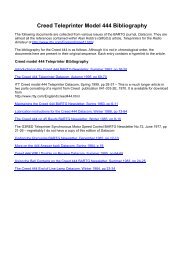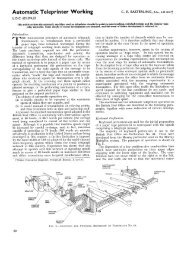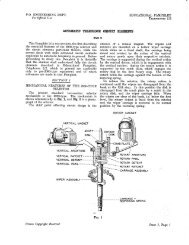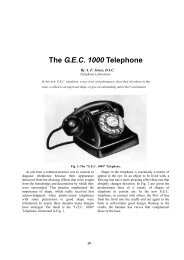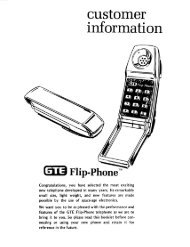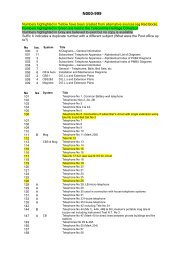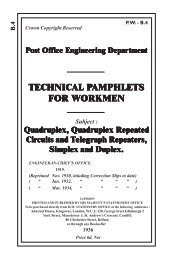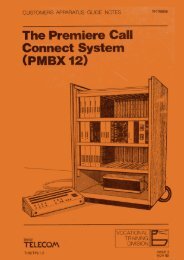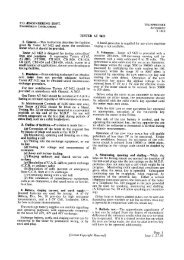TRAFFIC CONTROL TELEPHONE SYSTEMS Circuit - Sam Hallas
TRAFFIC CONTROL TELEPHONE SYSTEMS Circuit - Sam Hallas
TRAFFIC CONTROL TELEPHONE SYSTEMS Circuit - Sam Hallas
Create successful ePaper yourself
Turn your PDF publications into a flip-book with our unique Google optimized e-Paper software.
Page 36<br />
The “low” and “release” potentiometers are provided for the adjustment of the<br />
current through the selector for low and release tests.<br />
Lever type keys for applying the various test conditions.<br />
A centre zero micro-ammeter, with shunts for measuring test currents and<br />
observing the impulse ratio.<br />
A mounting with spring contacts which automatically connects the selector in<br />
the test circuit.<br />
Two terminals L1 and L2 for connecting the set to an outside line, and three<br />
terminals K1, K2 and K3 for connection to an external selector key, key case<br />
or external source of impulsing.<br />
When a key case is mounted in this manner it must be entirely disconnected<br />
from its associated selector apparatus case.<br />
The apparatus is mounted on a removable wooden panel in a wooden case with<br />
cover and carrying handle. Inside the cover is pasted a schematic (LP. 15500) of the<br />
test circuit, together with step-by-step instructions for operating the set, similar to<br />
the following :-<br />
Operating Instructions<br />
Connect a battery of 240 ± 8 V D.C. to the terminals so marked, and connect<br />
another battery of 10 ± 1 V D.C. to its marked terminals.<br />
Insert the selector key to be tested under the five spring terminals at the back of<br />
the selector tray, and operate the main switch.<br />
To Adjust the Test Set<br />
The Selector Key provided is a general call key, and will step any selector to its<br />
ringing position. The speed and ratio of this selector key should be checked in the<br />
following way :-<br />
Speed. — Operate the selector key and make sure that the time taken for the<br />
mechanism to run back, from start to finish, is between 7½ and 8 seconds. If<br />
the timing is not correct the governor springs of the key must be adjusted<br />
either inwards or outwards to obtain more or less speed respectively.<br />
Ratio.—Throw the Ratio Key (KIR on diagram). Again operate the selector<br />
key, and observe that when impulses are being transmitted the needle of the<br />
meter oscillates equally about the zero mark. If this is not so, variations can<br />
be eliminated by turning with a suitable screwdriver the head of the ratio<br />
rheostat in the centre of the panel (YJ on diagram). When this adjustment has<br />
been made restore the ratio key.<br />
Test Current.— Adjust the test currents through the selector by proceeding as<br />
follows :- Throw the "Low" key (KL on diagram) and hold the "Meter" key<br />
(KM on diagram) operated, then adjust the knob of the rheostat marked<br />
"low" till the micro-ammeter reads 125. The meter multiplier in this case is



